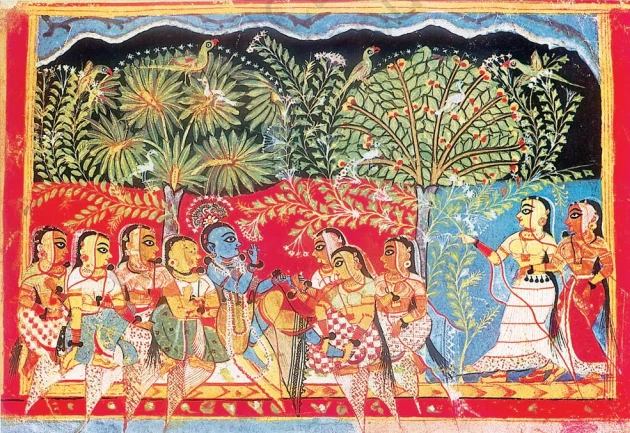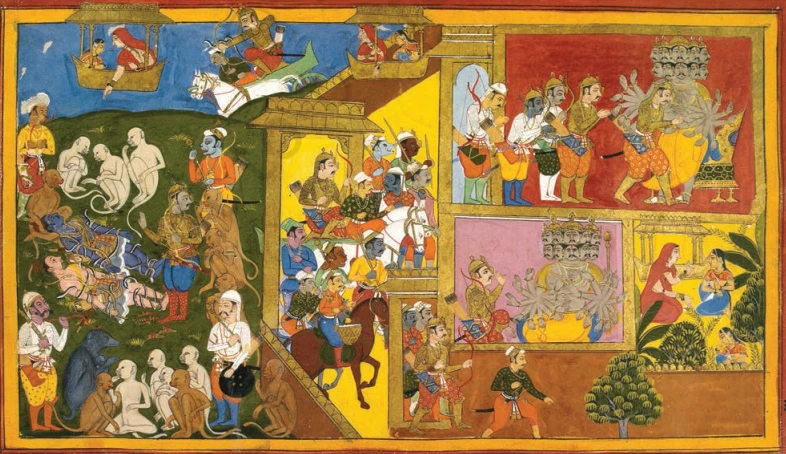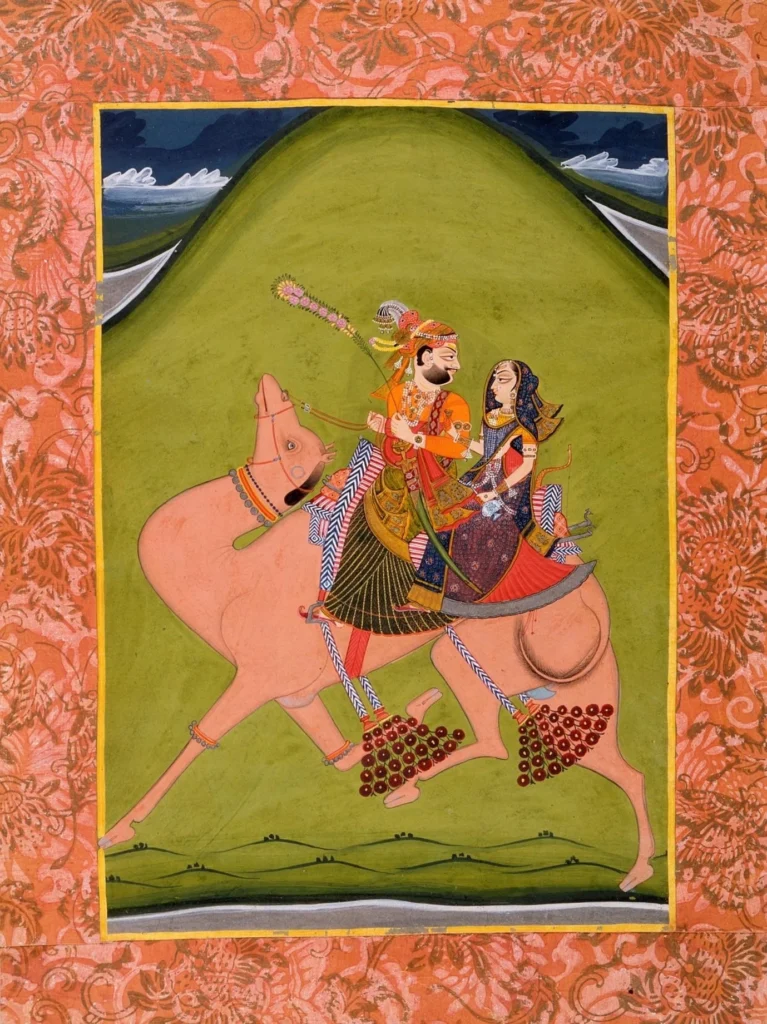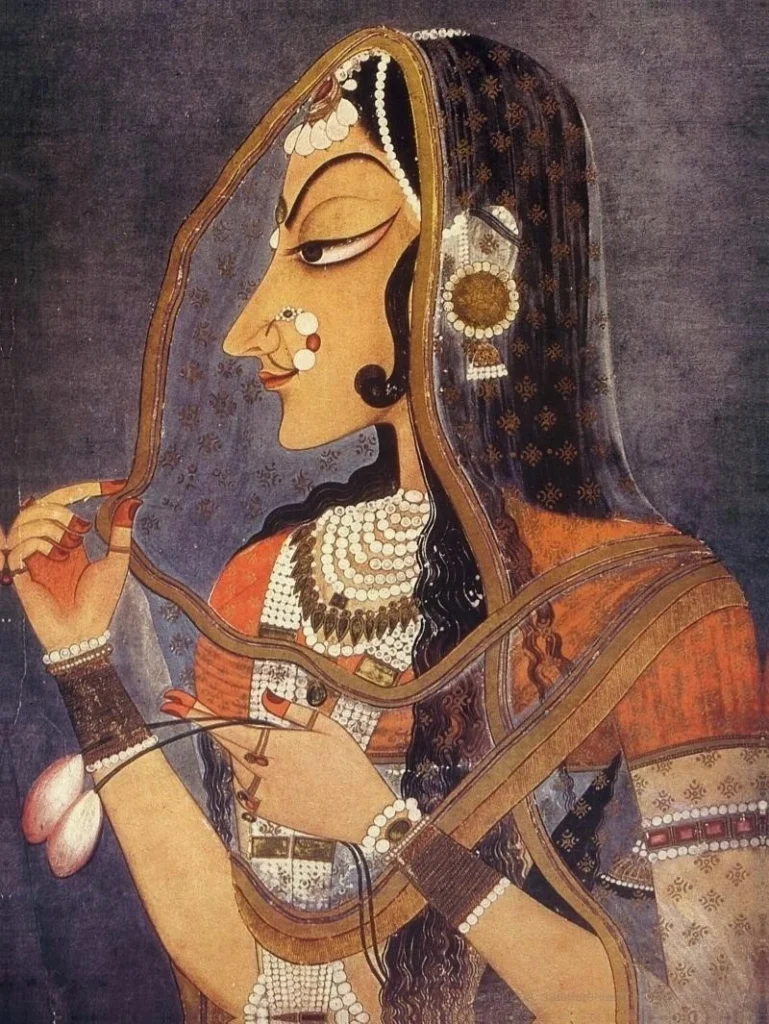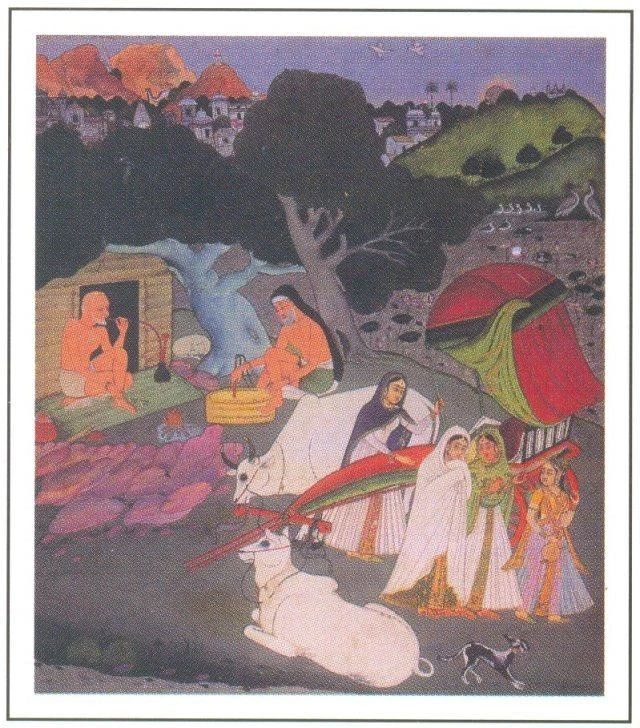The Rajput Painting or Rajasthani Schools of Painting refers to a style of painting that emerged during the era of Rajput Rulers. Reached its heights in the 17th and 18th centuries. This painting style is influenced by the Vaishnavism, Shaivism, and Sakti cults. Majorly the paintings highlighted societal values and the improvements that monarchs made for society.
Rajput Painting or Rajasthani Schools of Painting will be helpful for UPSC IAS Exam preparation. GS Paper-1 Art and Culture.
Content of Table
- What is Rajasthani Schools of Painting?
- Sources of Influence
- Salient Features of Rajput Painting (Rajasthani School of Painting)
- Mewar School of Painting
- Amber-Jaipur School of Painting
- Marwar School of Painting
- Kishangarh School Of Painting
- Bundi School Of Painting
- Conclusion
- Frequently Asked Questions (FAQs)
What is Rajasthani Schools of Painting?
- Rajput Painting or Rajasthani Schools of Painting is a style of painting that flourished in the princely states of Rajasthan in India during the 16th to 19th centuries.
- Characterized by its use of bright colors, intricate designs, and stylized figures.
- Originated from a confluence of influences, including:
- The Mughal Empire
- The Deccan Sultanates
- Indigenous traditions
- Patronized by the Rajput rulers of the region.
- Reached its peak in the 17th and 18th centuries.
- Types of Rajput Painting (Rajasthani Schools of Painting): Mewar, Marwar, Bundi, Kotah and Kishangarh.
- Declined in the 19th century, as the Rajput states were increasingly brought under British rule.
Sources of Influence
- The Mughal Empire: The Mughals were a Muslim dynasty that ruled much of India from the 16th to the 18th centuries.
- They were patrons of the arts and sciences, and they brought with them a rich tradition of painting from Central Asia.
- The Mughals influenced the school with their refinement of drawing and naturalism.
- The Deccan Sultanates: The Deccan Sultanates were a group of Muslim kingdoms that ruled much of the Deccan Plateau in India from the 14th to the 17th centuries.
- They were also patrons of the arts, and they brought with them a rich tradition of painting from the Middle East.
- Indigenous Traditions: The Rajasthani School of Painting was also influenced by indigenous traditions of painting that had developed in the region over centuries.
- These traditions included folk art, temple art, and Jain art.
Salient Features of Rajput Painting (Rajasthani School of Painting)
- The Rajasthani School of Painting is a deeply rooted Indian tradition.
- It was influenced by the Vaishnavism, Shaivism, and Sakti cults.
- The Krishna cults provided a rich canvas for the painter.
- The school is characterized by bold lines, powerful colours, and flat figures.
- The paintings sometimes have compartments of different colours.
- The paintings highlighted societal values and the improvements that monarchs made for the good of society.
- It used paper, ivory, and silk as its canvas.
Mewar School of Painting
- A style of painting that flourished in the princely state of Mewar in Rajasthan, India during the 16th to 19th centuries.
- Patronized by the Rajput rulers of Mewar.
Early Mewar Painting
- Dominated by the extraordinary painter of the 17th century, Sahibdin.
- Focuses on Sahibdin’s depiction of literary texts, including the Ragamala, the Ramayana, and the Bhagavata Purana.
- After Sahibdin’s death, the style of Mewari painting changed.
Later Mewar Painting
- Most of the paintings depicted life at the court in Mewar.
- The unique point of this period is the extraordinary ‘tamasha’ paintings that show court ceremonial and city views in unprecedented detail.
Amber-Jaipur School of Painting
- The Amber rulers were closely associated with the Mughals.
- They were major patrons and avid collectors of painting, but the Amber School is not as well-known as other schools.
- Much of the collection is in private hands and has not been published.
- The Amber School is also known as the Dundhar School, and its earliest evidence comes from the wall paintings at Bairat in Rajasthan.
- Some paintings can also be seen on the palace walls and mausoleum of Amer Palace in Rajasthan.
- Even though some of the menfolk are shown wearing Mughal-style clothing and headgear, the overall finish of the paintings is folk styled.
- This school reached its pinnacle during the reign of Sawai Pratap Singh in the 18th century.
- He was a deeply religious man and a passionate patron of art.
- These two factors combined to ensure that his surat khana, or department of painting, created miniatures to illustrate the Bhagwat Purana, Ramayana, Ragamala, and several portraits.
Marwar School of Painting
- The Marwar School of Painting is one of the most extensive schools of painting in India.
- It includes the Jodhpur, Bikaner, and Jaisalmer schools, which were all ruled by Rajput dynasties.
- The Marwar School of Painting was influenced by the Mughal style in the 15th and 16th centuries, but it developed its own unique style in the 18th century.
- The Marwar School of Painting is known for its many beautiful paintings, but the most famous paintings were produced during the reign of Man Singh (1803-1843).
- He commissioned extensive series of paintings, including the Shiva Purana, Natacharitra, Durgacharitra, Panchtantra, etc.
- The Kishangarh School and Bundi School are two of the most prominent sub-schools of the Marwar School of Painting.
Kishangarh School Of Painting
- The Kishangarh School of Painting is known for its romantic paintings, which often depict the love story of Sawant Singh and Bani Thani.
- The school was founded in the 17th century by Sawant Singh, who was a Rajput prince and a patron of the arts.
- He commissioned the painter Nihal Chand to create a series of paintings depicting his love for Bani Thani.
- The women in these paintings often have elongated eyes, thin lips, and pointed chins.
- They also typically wear a head covering called an odhni, which defines their side profile. The Kishangarh School of Painting is known for its beautiful and romantic paintings, which have captured the imagination of viewers for centuries.
Bani-Thani Painting
- Bani-Thani is an Indian painting in the Kishangarh school of paintings, painted by Nihal Chand.
- The painting’s subject, Bani Thani, was a singer and poet in Kishangarh in the time of King Sawant Singh (1748–1764).
- Bani Thani is depicted with elegant and graceful features, rather stylized, including arched eyebrows, lotus-like elongated eyes, and a pointed chin.
- Bani Thani was referred to as “she who is all dressed up” and was well known for her beauty and impeccable style.
- The painting is considered India’s “Mona Lisa” and is one of the most famous paintings of the Kishangarh school of paintings.
Bundi School Of Painting
- Hadoti: The collective name of the twin kingdoms of Bundi and Kota.
- Kota is home to some remarkable art and some remarkably eccentric patrons.
- The kings of Bundi and Kota were devotees of Krishna.
- In the 18th century, they declared themselves to be mere regents, ruling on behalf of the god who was the true king.
- Their Krishna-bhakti played a role in painting, or perhaps painting played a role in their Krishna-bhakti.
- The Bundi school of painting is characterized by:
- Detailed paintings of local vegetation.
- Round human faces with pointed noses.
- Skies painted in different colours, often with a visible red ribbon.
Conclusion
The Rajput Painting or Rajasthani School of Painting has many subgenres such as Mewar, Marwar, Bundi, Kotah and Kishangarh. Each subgenre has distinguished identities and uniqueness. The most prominent example of this painting style is the Bani-Thani Painting of the Kishangarh School Of Painting. Influence of the Mughal Empire, Deccan Sultanates and Indigenous Traditions can be seen in the Rajasthani Schools of Painting.
Ref: Source-1
| Other Articles in History & Culture | |
| Deccani Schools of Painting | Basic Feature of Hindu Temple |
| Orthodox Schools of Indian Philosophy | Kathakali |
| Kharosthi Script and Gupta Script | Guru Nanak |
FAQs (Frequently Asked Questions)
What are the different subtypes of Rajasthani Schools of Painting?
The Rajasthani School of Painting is a broad term that encompasses a number of different regional styles. The most well-known subtypes of Rajasthani painting are Mewar School, Kishangarh School, Bundi School, Amber-Jaipur School, and Marwar School.
Bani Thani Painting belongs to which school of painting?
The painting “Bani Thani” belongs to the Kishangarh school of painting. It was painted by Nihal Chand, a court painter of Raja Sawant Singh of Kishangarh in the 18th century.
What was the medium of Rajasthani Schools of Painting?
The Rajasthani Schools of Painting used gouache, a water-medium paint consisting of natural pigment, water, a binding agent or an opaque watercolour on paper.
When and where did the Rajasthani Schools of Painting originate?
The Rajasthani Schools of Painting is originated in the state of Rajasthan in the late 16th and early 17th century.
What is the difference between Mughal and Rajput miniature painting?
Mughal style leans aristocratic, while Rajput style tends towards democracy. Mughal art embodies realism, materialism, and secularism, whereas Rajput art exudes mysticism, spirituality, and a deep connection with religion.



